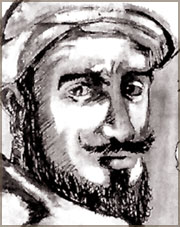|
DAILY NEWS ONLINE |
|
|
|
OTHER EDITIONS |
|
|
|
|
|
|
|
|
|
OTHER LINKS |
|
|
|
|
|
|
 |
Ibn Batuta, fourteenth century Sri Lankan tourist
|
|
|
In 1325, Abu Abdullah Muhammed Ibn Batuta, a 21 year Moroccan berber from Tangier, set out on a hajj to Mecca - then the capstone to his intended career as a godi or salaried magistrate of Koranic law.
That low-key departure however was the beginning of an adventure extraordinary that lasted 30 years and covered a distance of 120,000 km.
From Egypt Batuta went to Damascus in Palestine, the Turkish port of Alaniya, and on to Anatolia from where he went by the famous Turkish caravariserai to India.
Turkish
The Turkish lands greatly impressed him. "Its people are the most handsome of men" he wrote, "the cleanest in their dress, their food the most delicious, and they the kindest folk in all creation".
He admired the mighty Seljuk architecture and described Antalia as "a most beautiful city - one of the most attractive I have ever seen".
He praised the Turks for their faithful adherence to Sunni Islam, and the high status accorded their women. His only disapproval was that "they eat hashish and think no harm of it."
Serendib
Batuta came to Sri Lanka from the Maldives in 1344. "We were nine days under sail", he wrote, "and perceived the island of Serendib raised in the air like a column of smoke".
He was referring to the lone mountain of Sri Pada (Samanalakanda), symbol of Buddhist climbings, adorings and aspirations, which was also known to the Muslims from the 9th century, who venerated it as the place where Adam first stepped when God dismissed him from Eden.
Batuta landed on the Northwest coast "in the country of the Sultan Airy Chacarouaty (Ariya Chakravarti) a Tamil king who practised Saivism". At that time Bhuvanekabahu IV was ruling at Gampola and Parakramabahu V at Dadigama.
Batuta noted that cinnamon - the spice around which western nations were to dance in future - was already being traded. People from Malabar took away cinnamon bringing gifts of cloth for the king.
The Ariya Chakravarti had a large fleet which he used for trading in the Indian ocean. Batuta remembers seeing about a hundred of his ships of varying sizes on the Malabar coast.
The Ariya Chakravarti also had a variety of gems. One of them he never forgot was a ruby made into "a saucer as large as the palm of my hand containing oil of aloes".
Pilgrimage
When the Ariya Chakravarti learned that Batuta was a brother-in-law of his friendly ally the Sultan of Coramandel, and that his visit to Sri Lanka was for the purpose of making a pilgrimage to Adam's Peak, he readily provided him with the necessary means of transport - a dola or palanquin with bearers.
Batuta remembered seeing the wife of an Emir being carried in a palanquin when he was at Qiran in the Turkish lands. Now he was to be given the same privilege that was reserved for high dignitaries only.
On the way up to the top of the peak, Batuta noted "red roses (rhododendrons) as big as the palm of the hand growing on regular trees 50 feet high or more", and the wanderoo monkeys 'with beards like men'.
He also remembered the iron chains provided as an aid to pilgrims in the steeper parts of the climb, and the "fierce leech which dwells in trees and the grass, and when anyone comes near springs at them."
His most notable memory however was "the impression of the noble footprint of our Father Adam in a black and lofty rock in an open space, the foot sunken in the rock in such wise that its site is quite depressed: its length eleven spans".
Coast towns
Returning from Adam's Peak, Batuta visited the coastal towns of Galle (Qali), Devinuwara (Dinawar) and Colombo (Kalambu).
He saw Galle as a busy trade emporium with Chinese junks stopping on the way to Malabar, East Africa and back. He was treated by a resident merchant named Ibrahim, and met with many Muslim traders.
He also visited Devinuwara, a large town inhabited by merchants. He mentions a 'vast temple' served by a thousand priests and 500 dancing girls, containing an image of gold with ruby eyes.
Colombo, he said, was largely inhabited by Muslims, its trade controlled by a certain "Jalasti" with 500 Abysinians working for him. He was a "prince of the sea", actively engaged in foreign trade.
The extraordinary travelogue of Ibn Batuta, known as his Rihla, was written on his return to Morocco at the request of a Moroccan Sultan in Fez. It is considered a rich source of the life and times of the Muslim world of 1325 to 1354.
|
|
 |
 |
 |
 |

